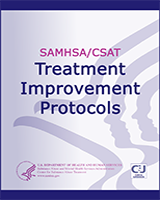NCBI Bookshelf. A service of the National Library of Medicine, National Institutes of Health.
This publication is provided for historical reference only and the information may be out of date.
This TIP, Clinical Guidelines for the Use of Buprenorphine in the Treatment of Opioid Addiction, provides consensus‐ and evidence‐based guidance on the use of buprenorphine, a new option for the treatment of opioid addiction. The goal of this TIP is to provide information that physicians can use to make practical and informed decisions about the use of buprenorphine to treat opioid addiction. The Guidelines address a number of topic areas related to this goal, including the physiology and pharmacology of opioids, opioid addiction, and treatment with buprenorphine; the screening and assessment of opioid addiction problems; detailed protocols for opioid addiction treatment with buprenorphine; management of special populations; and policies and procedures related to office‐based opioid addiction treatment under the paradigm established by the Drug Addiction Treatment Act of 2000. This TIP represents another step by CSAT toward its goal of bringing national leaders together to improve substance use disorder treatment in the United States.
Contents
- Acknowledgments
- What Is a TIP?
- Consensus Panel
- Panelists
- Buprenorphine Expert Panel
- Foreword
- Executive Summary
- 1 Introduction
- 2 Pharmacology
- Overview
- General Opioid Pharmacology
- The Functions of Opioids at Receptors
- Pharmacology of Buprenorphine
- Buprenorphine Safety, Adverse Reactions, and Drug Interactions
- Effectiveness of Buprenorphine Treatment
- The Buprenorphine/Naloxone Combination
- Diversion and Misuse of Either Buprenorphine Alone or the Buprenorphine/Naloxone Combination Product
- 3 Patient Assessment
- 4 Treatment Protocols
- 5 Special Populations
- Overview
- Patients With Medical Comorbidities
- Pregnant Women and Neonates
- Adolescents/Young Adults
- Geriatric Patients
- Patients With Significant Psychiatric Comorbidity
- Polysubstance Abuse
- Patients With Pain
- Patients Recently Discharged From Controlled Environments
- Healthcare Professionals Who Are Addicted to Opioids
- 6 Policies and Procedures
- Appendix A. Bibliography
- Appendix B Assessment and Screening Instruments
- Appendix C DSM‐IV‐TR Material
- Appendix D Consent to Release of Information Under Title 42, Part 2, Code of Federal Regulations
- Appendix E Clinical Toolbox: Chapter 3 Supplemental Information
- Appendix F Federation of State Medical Boards—Model Policy Guidelines for Opioid Addiction Treatment in the Medical Office
- Appendix G Stages of Change
- Appendix H Sample Treatment Agreement/Contract
- Appendix I Glossary
- Appendix J Field Reviewers
This publication was produced by the American Institutes for Research® (AIR) under the Center for Substance Abuse Treatment (CSAT) contract, task order number 277‐00‐6401 under the Substance Abuse and Mental Health Services Administration (SAMHSA) contract, Number 277‐99‐6400, U.S. Department of Health and Human Services (DHHS).
Suggested citation:
Center for Substance Abuse Treatment. Clinical Guidelines for the Use of Buprenorphine in the Treatment of Opioid Addiction. Treatment Improvement Protocol (TIP) Series 40. DHHS Publication No. (SMA) 04‐3939. Rockville, MD: Substance Abuse and Mental Health Services Administration, 2004.
The opinions expressed herein are the views of the consensus panel members and do not necessarily reflect the official position of CSAT, SAMHSA, or DHHS. No official support of or endorsement by CSAT, SAMHSA or DHHS for these opinions or for particular instruments, software, or resources described in this document are intended or should be inferred. The guidelines in this document should not be considered substitutes for individualized client care and treatment decisions.
- Statement of the American Society Of Addiction Medicine Consensus Panel on the use of buprenorphine in office-based treatment of opioid addiction.[J Addict Med. 2011]Statement of the American Society Of Addiction Medicine Consensus Panel on the use of buprenorphine in office-based treatment of opioid addiction.Kraus ML, Alford DP, Kotz MM, Levounis P, Mandell TW, Meyer M, Salsitz EA, Wetterau N, Wyatt SA, American Society Of Addiction Medicine. J Addict Med. 2011 Dec; 5(4):254-63.
- Review Buprenorphine for office-based treatment of patients with opioid addiction.[J Am Osteopath Assoc. 2005]Review Buprenorphine for office-based treatment of patients with opioid addiction.Manlandro JJ Jr. J Am Osteopath Assoc. 2005 Jun; 105(6 Suppl 3):S8-13.
- Geographic and specialty distribution of US physicians trained to treat opioid use disorder.[Ann Fam Med. 2015]Geographic and specialty distribution of US physicians trained to treat opioid use disorder.Rosenblatt RA, Andrilla CH, Catlin M, Larson EH. Ann Fam Med. 2015 Jan-Feb; 13(1):23-6.
- Review Consensus statement on office-based treatment of opioid dependence using buprenorphine.[J Subst Abuse Treat. 2004]Review Consensus statement on office-based treatment of opioid dependence using buprenorphine.Fiellin DA, Kleber H, Trumble-Hejduk JG, McLellan AT, Kosten TR. J Subst Abuse Treat. 2004 Sep; 27(2):153-9.
- Review Using buprenorphine for outpatient opioid detoxification.[J Am Osteopath Assoc. 2007]Review Using buprenorphine for outpatient opioid detoxification.Manlandro JJ Jr. J Am Osteopath Assoc. 2007 Sep; 107(9 Suppl 5):ES11-6.
- Clinical Guidelines for the Use of Buprenorphine in the Treatment of Opioid Addi...Clinical Guidelines for the Use of Buprenorphine in the Treatment of Opioid Addiction
- Chain A, ARGININE REPRESSORChain A, ARGININE REPRESSORgi|1421321|pdb|1XXC|AProtein
- IGSF11-AS1 IGSF11 antisense RNA 1 [Homo sapiens]IGSF11-AS1 IGSF11 antisense RNA 1 [Homo sapiens]Gene ID:100506765Gene
Your browsing activity is empty.
Activity recording is turned off.
See more...
